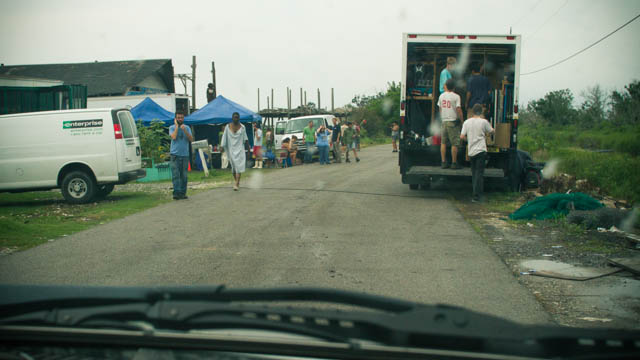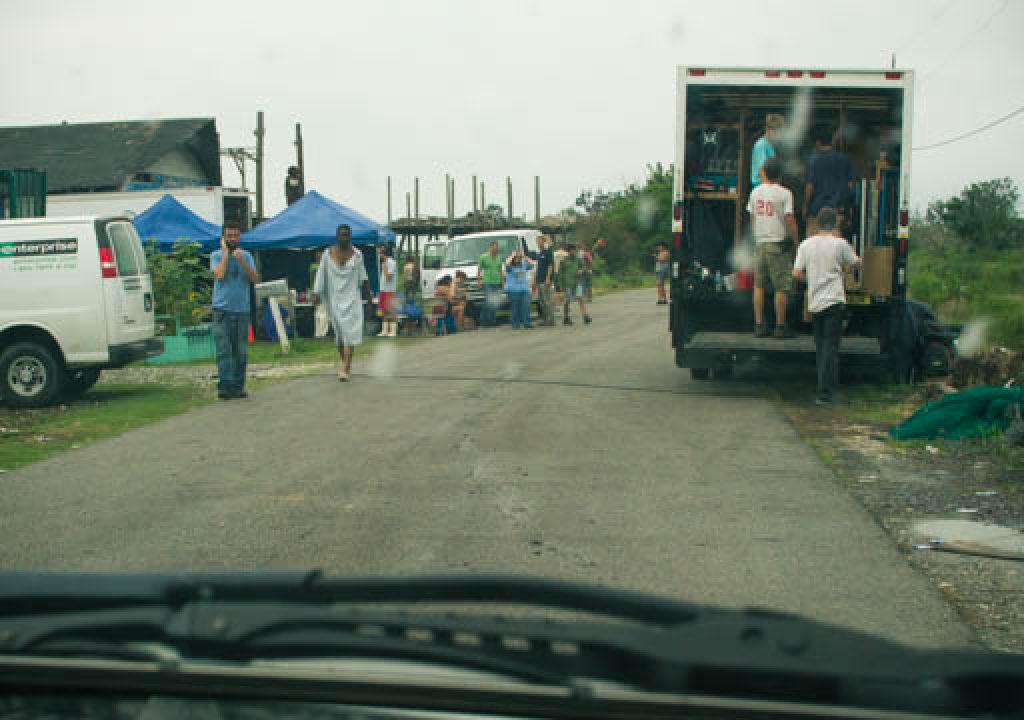The text came in late one evening – who could be in New Orleans immediately for VFX supervision? The call was going around San Francisco, apparently because the film had received SF Film Commission backing which stipulated hiring local artisans, despite shooting along the Gulf of Mexico. The production had been working with a supervisor (Chris Healer from The Molecule) who was suddenly unavailable for a key part of the shoot. Within a short time I was on the phone with producer Josh Penn to discuss Beasts of the Southern Wild, an independent film in production in 2010 that had been considered “un-filmable” at Sundance Writers' Workshop the previous year because the very title required creatures – beasts – on a standard independent film budget well below $2 million.
The solution that we all now know about was baby pigs in costumes. I was initially a little reluctant. It's a little funny now to think that I tried to throw another candidate or two their way, but I had already committing to spending that week with my kids, who were on vacation, and, well, trained baby pigs wearing furs and horns? Then I watched Glory at Sea, Benh Zeitlin's short film on a related (Hurricane Katrina-inspired) theme, I gilmpsed what they were going for – a mythical visual poem rather than the Bovine Godzilla. And when it became clear that, since there were caregivers and kids on set, my kids could even come along – well, who could say no to something like that.
There are many great stories associated with this shoot, some of them documented on the excellent 2-disk bluray DVD set which the gracious producers even sent to all of us who participated. I found myself heading straight to ground zero of the BP oil spill crisis and vividly recollect being greeted on set by Josh with the words, “welcome to the end of the world.” On the final day of the trip, a visit with Ray Tintori to the abandoned New Orleans firehouse that served as the VFX facility (and pig farm) sparked the idea that led me to pitch what is now Cinefex for iPad. I also learned a few vivid lessons I thought I'd write up, to commemorate Oscar week and celebrate this year's biggest independent Hollywood success.

Arrival at the set. Josh Penn (on phone left, next to Dwight Henry): “Welcome to the end of the world.”
LESSON 3.1415: You are a smart, resourceful filmmaker? That means your project has a high likelihood of succeeding – but only with a bunch more heart, guts and legs underneath.
Showing up on the set of Beasts was me jumping on a moving train. I was to be the VFX brain on the shoot, and I almost blew it by staying too much in my head.
By the time we finally had an opportunity to go over the pivotal VFX sequence of the film, in which Hushpuppy comes face to face with the aurochs, the Beasts of the title, it was a 15 minute huddle around a picnic table in the dying light of the previous day. I felt certain from the hand-waving, script description and some quick sketches that I understood what was happening the next day, but in retrospect the most useful thing I could have done at that point was to assume that I understood nothing until I found any way possible to put that scene in motion with even the dirtiest, crudest animatic. As it turned out, while I thought I perfectly understood what we were shooting, when the climactic shot happened, in which the girls run screaming from the charging beasts, there was one surprise variable – the DP was running backward. After a brief reminder to the DP Ben Richardson to please try and keep the camera on-axis, I calmed back down, but my job was to foresee and plan for this eventuality. Which leads me to the next point…
DP Ben Richardson prepares to shoot Hushpuppy's confrontation with the aurochs.
LESSON 23.976: Go ahead, kill yourself to make your movie, but save all the drama for the screen, and your cast and crew will follow you to the end of the earth.
Only one other time have I encountered a crew and cast as dedicated to a project as on Beasts, when I VFX supervised All About Evil for director Joshua Grannell, and that production was about 1/3 the size of what Court 13 assembled in the bayou. I count myself incredibly fortunate to have experienced either production; some VFX artists spend an entire career never working on a movie they even like. The highly dedicated crew, living on no money in a part of the world where it's possible to do that, dedicated their summer and more to the wild adventure of work on Beasts. Benh Zeitlin, Lucy Alibar, Josh Penn, Michael Gottwald, Ben Richardson (and thus everyone who worked with them) radiated commitment to their story and enthusiasm for challenges.
All I can say is, recent film school graduates, if you find yourself choosing between spending some time in the Louisiana bayou working on a Court 13 project for next to nothing, in a region where you can live on next to nothing, or trying the same in New York or LA – well, those other places will still be there.
Commitment – right down to the detail and motion provided by the auroch stand-in.
LESSON 1979: Old School Rules.
Are you producing an independent film on your own budget? Then design it to work better for $500k or a million bucks than it ever possibly could with 10x, or 100x that amount. The best independent directors know exactly what they want, and don't switch to some hail-Mary plan involving unfamiliar techniques. Just because pure-digital filmmaking is possible doesn't mean it is always the way. Digital in aid of practical, not as the star? Absolutely, if it works for the production.
At the VFX facility: Auroch costume prototype.
LESSON 47: Create your own luck with hard work.
I had a gut feeling something was going to happen with this movie at Sundance, and when at the last minute it turned out I would be able to go, I knew I was missing their moment. Of course I had no idea it would achieve the cinematic achievement of the triple crown – winning Sundance, the Camera D'Or and being nominated for Best Picture (which I take to be a bigger deal even than winning, which would be seen as a fluke).
Why did I have that feeling? I don't entirely know – everyone believes in their project, but I'd been around enough productions to know that this one had energy behind it that simply had to go somewhere. The filmmakers did their best to make it impossible for it not to.
Producer Josh Penn
LESSON -13: Kill those babies.
I finally saw Beasts of the Southern Wild for the first time in its opening week at the Arclight in LA (my kids joined me), and I was more than mildly surprised to see more than one of the sequences that we carefully staged during my visit to the bayou completely missing from the movie. Only when I reviewed the DVD that the production was classy enough to send me did I see that this movie sets some kind of record for scenes that would fit perfectly and are excised – so strongly did the director and writer feel that only the scenes that supported the central emotional drama between Wink and Hushpuppy belonged in the movie.
I know I would not have made those cuts, and I'm still really not sure I agree with all of them – except I would have been wrong. Beasts of the Southern Wild needed not to overstay its welcome, and at 90 minutes it may have felt at moments like a bit of a cipher, but it avoided any of that that Hobbit aftertaste of over-indulgence that frankly would have sunk this project's likelihood of success.
In 20 years or so, maybe Benh Zeitlin will release his Director's Cut (which will only be 10 minutes longer) and restore a few scenes that would allow this intense adventure breathe a little. If so, loyal fans from Speilberg to the Obamas will no doubt declare their preference for the original.
Effects supervisor Ray Tintori and his crew prep the dead aurochs, even dressing them with fresh cattle organs (note earplugs in nose). They didn't make the cut.
LESSON 2013: Beasts of the Southern Wild is unprecedented and the Cinderella story of 2012, and Hollywood desperately needs a lot more like it.
Hollywood loves a good Cinderella story, and the Oscars have made darlings of “independent” films since the days of Sex, Lies and Videotape. Some of these so-called independents are actually well-bankrolled, fully Hollywood smaller-budget films. My definition of a true independent film is one made with no studio distributor involvement whatsoever (and thus, alas, no guaranteed form of recouping its costs). The filmmaker gets a chance to execute his or her vision without having to answer to marketers.
It has never been harder to recoup costs from an independent film. It's funny to think that a few years ago, you could make a movie in specific genres – horror, sci fi and porn come to mind, but also comedy – and be virtually guaranteed that if you kept the budget in line and played the game correctly, you could make your money back. Those days are gone. Among the many thousands of films that were produced in 2012 with the hopes of gaining success at Sundance and finding a distributor, only a handful passed even the first hurdle, and among the rest, none found anything like the distribution, marketing and critical acclaim that greeted Beasts.
At the other end of the scale, there is the sense that maybe Hollywood can no longer support the megabudget tentpole releases that are its major focus. In an article published in Variety last week, David Cohen went so far as to say that the failure of the visual effects industry that supports these movies may be the “canary in the coal mine” indicating that they are in trouble.
Benh Zeitlin has made his last independent film for a while, but he's smart enough to pursue a strategy to make films that make money. Robert Rodriguez is another filmmaker I've worked with who has managed to stay more independent than most by delivering a profit every time.
The success of Beasts of the Southern Wild will not change the game for your independent project until the distribution system changes to allow for more such phenomena to occur on their own. It looks grim right now given how few pictures find their way to your local cineplex, and how many of the rest just succumb to piracy, but finding more smaller profitable projects instead of rolling the dice on make-or-break gambles is exactly what Hollywood now needs to do in order to remain a viable entertainment business.
On set: focus in the midst of chaos, destruction and high humidity.
BONUS LESSON +1: Once in a while, consider bringing the kids along.
I'm thrilled that not only I but my kids have a connection to this amazing movie. For them, who knows how it will influence their creative lives to have been part of this project when it was nothing but a bunch of talented, hard-working people gathered out in a half-wrecked part of the poorest state in the union. Sets are not usually places for kids, so we obviously lucked out here; they were able to appreciate the tedium of filmmaking from a kid's point of view, and even to learn that the patience can pay off.


